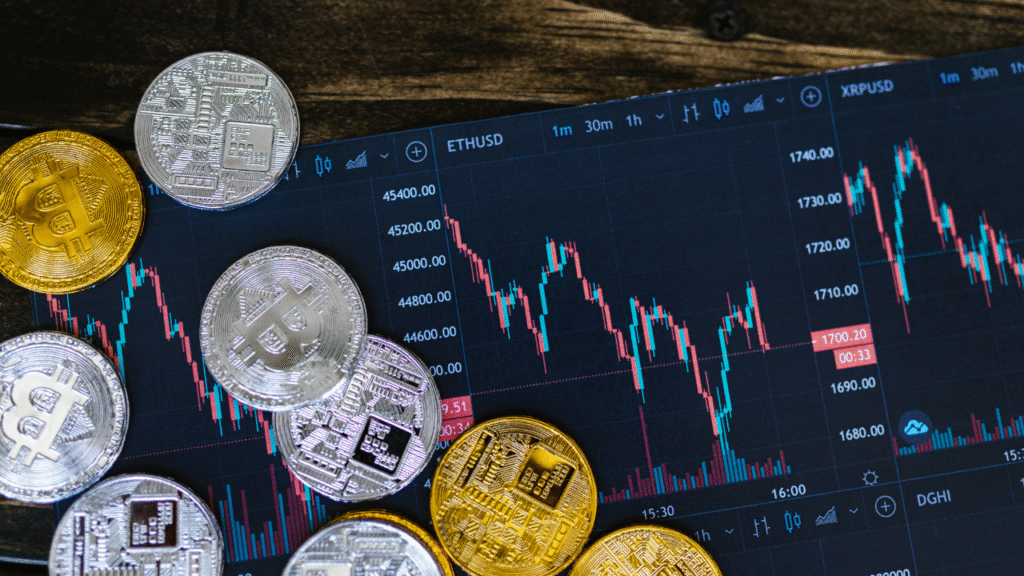“Time in the market beats timing the market.” I love that line because it flips the script: you don’t need to be a day-trading wizard to build wealth. In this comprehensive starter guide to crypto investment for millennials, we’ll outline a clear path—defining goals and risk, selecting the right wallets and exchanges, utilizing dollar-cost averaging, and avoiding the scams that often trip up beginners. Short, punchy steps when you’re in a rush. Deeper explanations when it matters. Let’s make self-custody, diversification, and long-term thinking your new superpowers!
You can dive deeper into the details and insights by reading the full Project Serenity review here. It’s the best way to see exactly how it works, the benefits it offers, and whether it’s right for you.
📈 Why Millennials Are Leaning Into Crypto
💸 Economic Context: Inflation, Student Debt, and Asymmetric Upside
- Inflation erodes cash savings; crypto offers scarcity-based assets (e.g., capped supply coins) and yield options versus near-zero savings APY.
- High student loan burdens push interest toward assets with outsized upside potential on small allocations.
- 24/7 global markets and low minimums enable gradual entry (micro-buys, DCA) without large upfront capital.
- Stablecoins as a cash hedge for remittances and faster payments; on-chain yields (with risk controls) as alternatives to legacy accounts.
📱 Digital-Native Comfort with Apps, Neobanks, and Web3
- Mobile-first users already trust fintech UX (neobanks, P2P payments); wallets feel like the next logical step.
- Self-custody and DeFi align with open-internet values: permissionless access, transparent ledgers, composable apps.
- Familiarity with NFTs, gaming, and creator tools lowers the barrier to on-chain participation.
- Automation (price alerts, auto-DCA, portfolio trackers) meets preference for set-and-forget tools.
🕒 Long Time Horizon = Compounding Advantage
- Millennials can exploit time in market: DCA smooths volatility and compounds outcomes across cycles.
- Reinvest staking rewards / yield to boost long-term totals; schedule periodic rebalancing to control risk.
- Focus on behavioral edge: avoid FOMO trades, set rules, and maintain emergency cash so you’re never forced to sell.
- Use tax-aware holding periods and documented cost basis to preserve gains.
₿ Role of Bitcoin vs. “Tech Thesis” on Ethereum and L2s
- Bitcoin (BTC): “Digital gold” narrative, fixed supply, store-of-value core holding for macro hedge and simplicity.
- Ethereum (ETH): Programmable money powering DeFi/NFTs; staking and fee-burn dynamics support a tech-growth thesis.
- Layer-2s (Optimistic & ZK): Scale Ethereum with lower fees, expanding use cases (payments, gaming, social).
- Portfolio framing: core-satellite (BTC as core stability; ETH/L2s/infrastructure as higher-beta satellites).
- Consider regulatory paths (spot ETFs, staking regulations), smart-contract/bridge risks, and diversification across ecosystems.
Discover the full details of Project Serenity here and see why it’s creating a buzz among investors.
🎯 Define Your Goals & Risk Profile

💼 Investment Objectives: Wealth Building, Income, or Experimentation
- Wealth Building: Long-term capital growth through holding core assets like BTC and ETH, reinvesting gains, and compounding over years.
- Income Generation: Using staking, yield farming, or lending to earn ongoing passive returns, with a focus on risk-adjusted yield.
- Experimentation: Smaller allocations to high-risk, high-reward plays (altcoins, NFTs, early-stage DeFi protocols) for learning and potential upside.
- Decide the primary purpose before allocating funds — it shapes asset selection, risk, and liquidity needs.
⚖ Risk Tolerance, Capacity, and Time Horizon
- Risk Tolerance: Your emotional comfort with volatility — can you handle 50% drawdowns without panic selling?
- Risk Capacity: Your financial ability to take risk — based on income stability, debt levels, and emergency savings.
- Time Horizon: How long you can hold before needing the capital — longer horizons allow more exposure to volatile, high-growth assets.
- Align all three for a portfolio you can stick with through cycles.
🧩 Core vs. Satellite Allocation Framework
- Core Portfolio: 60–90% in established assets (BTC, ETH, blue-chip infrastructure) for stability and predictable long-term growth.
- Satellite Positions: 10–40% in thematic or speculative plays (L2s, DeFi, metaverse, gaming tokens).
- This structure balances upside potential with downside protection.
- Rebalance periodically to maintain target allocations as markets move.
📏 Setting Realistic Return Expectations and Benchmarks
- Avoid unrealistic goals like “10x in a year” — focus on sustainable annualized growth that compounds over time.
- Use benchmarks like BTC’s historical CAGR, crypto market index returns, or traditional 60/40 portfolio performance for context.
- Factor in fees, taxes, and inflation when setting net return targets.
- Build flexibility: adjust expectations based on market phase (bull, bear, accumulation).
Start your journey toward financial freedom with Project Serenity today.
🔐 Wallets & Security 101 (Custodial vs. Self-Custody)
🏦 Custodial Exchange Wallet vs. Non-Custodial Mobile/Hardware Wallet
- Custodial Wallets: Provided by centralized exchanges; they hold the private keys for you. Convenient for trading and recovery, but assets are subject to exchange security and solvency.
- Non-Custodial Wallets: You own and control your private keys via mobile apps (e.g., MetaMask, Trust Wallet) or hardware wallets (e.g., Ledger, Trezor). Full control means full responsibility for backups and security.
🔑 Seed Phrase, Passphrase, and Private Key Basics
- Seed Phrase: A 12–24 word master backup that can restore your wallet and funds on any compatible device.
- Passphrase (25th Word): An optional extra password layered onto the seed phrase for hidden or secondary wallets.
- Private Key: A cryptographic code that gives full access to your wallet. Must never be shared or stored online.
🌐 Hot vs. Cold Storage for Different Balances
- Hot Wallets: Internet-connected; ideal for small balances and frequent transactions but more exposed to hacking risks.
- Cold Wallets: Offline storage (hardware devices, paper wallets) for larger, long-term holdings; highly secure against online threats.
🛡 Essential Habits for Crypto Security
- Enable 2FA: Use authenticator apps (not SMS) for exchange and wallet logins.
- Phishing Safety: Verify URLs, bookmark official sites, and never click unknown links.
- Test Transactions: Send a small amount before large transfers to confirm details.
- Approval Revokes: Regularly check and remove unused smart contract permissions via trusted tools like Revoke. cash or Etherscan’s Token Approval Checker.
Learn how you can unlock new investment opportunities through Project Serenity.
💱 Exchanges, On-Ramps & Fees

🏛 Centralized Exchanges (CEX) vs. Decentralized Exchanges (DEX)
- CEX: Platforms like Binance, Coinbase, or Kraken that match buyers and sellers using an internal order book. They offer high liquidity, fiat on-ramps, and customer support but require KYC verification and involve counterparty risk.
- DEX: Platforms like Uniswap, PancakeSwap, or Curve that use smart contracts and liquidity pools for peer-to-peer trading. They provide self-custody, global access, and privacy but may have lower liquidity and require higher technical know-how.
💳 Payment Methods & Fee Trade-Offs
- Bank Transfer: Usually the lowest fees but can take 1–3 business days for processing.
- Debit/Credit Card: Instant buys but higher fees (2–5% typical) and potential cash advance charges.
- P2P (Peer-to-Peer) Marketplaces: Flexible payment options, but you must vet counterparties and use escrow for safety.
- Third-Party On-Ramps: Services like MoonPay or Ramp, offering integrated purchase options directly inside wallets or apps.
📊 Liquidity, Slippage, and Spread Explained
- Liquidity: The amount of available supply for a trading pair—higher liquidity reduces price impact when trading.
- Slippage: The difference between the expected price and the executed price due to order size or market volatility; set slippage tolerance on DEXs to control risk.
- Spread: The difference between the highest bid and lowest ask prices on an exchange; tighter spreads mean better trading efficiency.
🛡 KYC/AML Considerations & Account Security Checklist
- KYC/AML Compliance: Required on most regulated CEXs; involves identity verification to meet anti-money laundering laws.
- Security Practices:
- Enable 2FA with an authenticator app.
- Whitelist withdrawal addresses.
- Set up withdrawal confirmations via email/SMS.
- Use strong, unique passwords stored in a password manager.
- Be aware of jurisdictional restrictions and ensure the exchange operates legally in your region.
Check out Project Serenity’s exclusive program and see if it’s the right fit for you.
🪙 What to Buy First (Core Crypto Building Blocks)

₿ BTC as Store-of-Value Core
- Bitcoin (BTC): Limited supply of 21 million coins, decentralized network, and established track record as “digital gold.”
- Serves as a macro hedge against currency debasement and inflation.
- Most suitable as a core portfolio anchor for long-term holding due to its relative stability in the crypto market.
💻 ETH as Programmable Money
- Ethereum (ETH): Powers decentralized applications (DeFi, NFTs, gaming) via smart contracts.
- Offers staking yields and benefits from fee-burn mechanics introduced in EIP-1559, creating potential deflationary pressure.
- Acts as both a growth asset (tech adoption) and a utility token (gas for transactions).
🛠 L2s, Blue-Chip DeFi, and Infrastructure Picks
- Layer-2 Networks (L2s): Optimism, Arbitrum, zkSync for scaling Ethereum with faster, cheaper transactions.
- Blue-Chip DeFi: Established protocols like Aave, Uniswap, Curve with high TVL and proven security history.
- Infrastructure Projects: Chainlink (oracle services), The Graph (data indexing), Polygon (multi-chain scaling).
- These act as satellite positions for diversification and higher growth potential.
💵 Stablecoins for Dry Powder and Yield Strategies
- Examples: USDC, USDT, DAI for maintaining liquidity and hedging volatility.
- Used for quick deployment into opportunities or for yield generation via staking, lending, or liquidity provision.
- Important to assess collateral backing and issuer transparency before holding large balances.
📈 Crypto ETFs/ETNs as a Regulated On-Ramp
- Exchange-traded products tracking BTC or ETH prices; available in certain jurisdictions.
- Offer regulated exposure without direct custody of assets.
- Ideal for investors who prefer a familiar brokerage environment or want crypto exposure in tax-advantaged accounts.
Ready to take the next step? Explore Project Serenity now.
📊 Beginner-Friendly Strategies
📅 Dollar-Cost Averaging (DCA) & Automated Buys
- Invest a fixed amount at regular intervals (e.g., weekly, monthly) regardless of market price.
- Smooths out volatility and removes the stress of market timing.
- Most exchanges and wallet apps allow auto-buy setups to make DCA effortless.
📈 Buy-and-Hold with Periodic Rebalancing
- Accumulate and hold core assets (e.g., BTC, ETH) for the long term.
- Review your portfolio quarterly or annually to rebalance to target allocations.
- Rebalancing can lock in gains from outperforming assets and reinvest in undervalued ones.
🧩 Core–Satellite Portfolio Design (e.g., 70/20/10)
- Core (70%): Established, lower-volatility assets like BTC, ETH.
- Satellites (20%): High-potential altcoins, L2 networks, blue-chip DeFi projects.
- Speculative (10%): High-risk plays like new tokens, NFTs, experimental DeFi.
- Provides diversification while keeping risk in check.
🚫 “Do Nothing” Rules: Avoiding Overtrading & FOMO
- Set predefined rules for buys and sells; avoid reacting to short-term market noise.
- Unfollow hype-driven social media to minimize emotional trading triggers.
- Remember: consistent execution beats impulsive decisions in long-term performance.
Discover what makes Project Serenity different from anything you’ve tried before.
💰 Earning on Your Crypto (Staking, Savings, DeFi)

🔗 Native Staking vs. Liquid Staking; Lockups and Rewards
- Native Staking: Lock your crypto directly on-chain (e.g., ETH on Ethereum, ADA on Cardano) to help secure the network and earn rewards. Typically involves fixed lock-up periods and minimum staking amounts.
- Liquid Staking: Stake via protocols like Lido or Rocket Pool to receive a liquid token representing your staked asset, allowing you to use it in DeFi while still earning staking rewards.
- Compare annual percentage yields (APY), compounding frequency, and validator reputation before staking.
🏦 CeFi Savings vs. On-Chain Yield; Counterparty vs. Smart-Contract Risk
- CeFi Savings: Deposit assets into centralized platforms (e.g., exchanges, lending services) offering interest payouts. Easier to use but exposes you to custodian default risk.
- On-Chain Yield: Earn through decentralized protocols (Aave, Compound, Maker) without giving up custody; however, subject to smart-contract exploits and protocol-specific risks.
- Assess your comfort with each risk type and diversify yield sources accordingly.
⚖ Using DEXs and Money Markets Safely
- Grant token allowances only to verified contracts from reputable projects.
- Check audit reports, bug bounty programs, and TVL (total value locked) for signs of protocol security.
- Avoid overexposure to a single pool or protocol — use position caps to limit potential loss.
💤 When to Prefer Simplicity Over Yield Chasing
- High APYs often signal higher risk or unsustainable token incentives.
- If you’re new, prioritize stable, well-known protocols and moderate yields over chasing maximum returns.
- Balance yield generation with overall portfolio safety and liquidity needs.
⚠ Risk Management & Red Flags
📏 Position Sizing, Stop-Loss Mindset, and Scenario Planning
- Limit each trade or investment to a set percentage of your portfolio (e.g., 1–5%) to reduce impact from a single loss.
- Adopt a stop-loss mindset — decide in advance at what price or condition you’ll cut losses.
- Use scenario planning to prepare for market crashes, exchange outages, or regulatory shocks.
- Maintain an emergency cash buffer so you’re never forced to liquidate assets in unfavorable conditions.
🔗 Smart-Contract Risk, Bridge Risk, and Stablecoin De-Peg Risk
- Smart-Contract Risk: Even audited code can contain vulnerabilities — only use reputable, time-tested protocols.
- Bridge Risk: Cross-chain bridges are frequent hack targets; avoid holding large amounts in bridged assets.
- Stablecoin De-Peg: Choose stablecoins with strong collateralization and transparency; diversify to reduce issuer-specific risk.
📊 Tokenomics Checks: Supply Unlocks, Emissions, Utility
- Review vesting schedules and supply unlock events that could flood the market and depress price.
- Understand token emission rates and whether inflation is offset by burns or growing demand.
- Assess the real utility of the token — governance, staking, collateral — to gauge sustainable demand.
🚫 Scam Patterns: Fake Airdrops, Impostor Domains, Support DM Traps
- Fake Airdrops: Beware of unsolicited tokens in your wallet; interacting with them can grant attackers access.
- Impostor Domains: Always double-check URLs for exchanges and DApps; bookmark official links.
- Support DM Traps: No legitimate support team will ask for your seed phrase or private keys.
- Report and block suspicious accounts immediately.
🧾 Taxes & Record-Keeping (Millennial Edition)
💰 Taxable Events: Buys, Sells, Swaps, Staking Rewards, NFTs
- Buys: Usually not taxable until sold, but check jurisdiction-specific rules for reporting requirements.
- Sells & Swaps: Trigger capital gains/losses based on the difference between cost basis and sale price.
- Staking Rewards & Yield: Often treated as income at the fair market value when received.
- NFT Transactions: Both sales and trades can be taxable; minting costs may be deductible in some jurisdictions.
📊 Cost Basis Tracking, Lot Selection, and Statements
- Track cost basis for each purchase to calculate gains/losses accurately.
- Use lot selection methods (FIFO, LIFO, specific ID) based on your tax strategy and local regulations.
- Keep detailed statements from exchanges, wallets, and DeFi platforms for year-end reporting.
⚙ Tools to Automate Reports; When to Consult a Pro
- Use tools like Koinly, CoinLedger, CoinTracking, or Accointing to sync wallet and exchange transactions automatically.
- Automate gain/loss calculations, staking income tracking, and tax form generation.
- Consult a crypto-savvy tax professional if you trade across multiple chains, use complex DeFi strategies, or have large transaction volumes.
🌍 Cross-Border Moves and Compliance Reminders
- Moving between countries can create exit taxes or require immediate asset declaration.
- Stay aware of reporting requirements for foreign-held crypto accounts (e.g., FBAR in the U.S.).
- Maintain compliance with KYC/AML laws when moving assets through exchanges or payment gateways.
📂 Sample Portfolios You Can Copy-Edit
🛡 Conservative: 80% BTC/ETH, 15% Stables, 5% Blue-Chip DeFi
- BTC/ETH (80%): Core allocation focused on long-term value and lower volatility compared to smaller-cap crypto assets.
- Stablecoins (15%): USDC, USDT, or DAI for liquidity and market dip opportunities.
- Blue-Chip DeFi (5%): Established protocols like Aave, Uniswap, or Curve for potential yield and sector exposure.
⚖ Balanced: 60% BTC/ETH, 20% L2/Infrastructure, 15% Stables, 5% NFT Index
- BTC/ETH (60%): Solid foundation for stability and market correlation.
- Layer-2 / Infrastructure (20%): Networks like Polygon, Arbitrum, or Chainlink to capture scaling and adoption growth.
- Stablecoins (15%): Dry powder for opportunistic buys or yield strategies.
- NFT Index (5%): Exposure to the NFT market via index tokens or diversified NFT funds.
🚀 Adventurous: 50% BTC/ETH, 25% L2/Infra, 15% DeFi, 10% Tactical Themes
- BTC/ETH (50%): Base layer for resilience in downturns.
- Layer-2 / Infrastructure (25%): Higher growth potential plays tied to blockchain scalability.
- DeFi (15%): Mix of lending, DEX, and yield protocols with strong fundamentals.
- Tactical Themes (10%): Rotating exposure to narratives like gaming, metaverse, or AI-linked crypto.
🔄 Rebalancing Cadence & Drift Thresholds
- Cadence: Review allocations quarterly to maintain strategy alignment.
- Drift Threshold: Adjust positions if allocation deviates more than 5% from the target.
- Rebalancing Method: Use stablecoins or new contributions to bring weights back in line before selling appreciated positions to reduce tax impact.
Your breakthrough could start with Project Serenity—find out how.
📲 Tools, Apps & Learning Hubs

📊 Portfolio Trackers, Tax Software, and Alert Bots
- Portfolio Trackers: Tools like CoinStats, Delta, or CoinMarketCap Portfolio to monitor holdings across wallets and exchanges in real time.
- Tax Software: Platforms such as Koinly, CoinLedger, or Accointing to automate transaction syncing, gains/losses calculations, and report generation.
- Alert Bots: Set price, volume, or on-chain activity alerts via apps like CoinGecko, TradingView, or custom Telegram/Discord bots.
🔒 Security Add-Ons: Hardware Wallets, Approval Scanners, Password Managers
- Hardware Wallets: Ledger, Trezor, or Keystone for offline private key storage and enhanced self-custody.
- Approval Scanners: Revoke.cash or Etherscan’s Token Approval Checker to review and remove risky contract permissions.
- Password Managers: Bitwarden, 1Password, or LastPass to store unique, complex passwords securely.
📚 Research Flow: Whitepapers, Token Dashboards, Reputable News Sources
- Whitepapers: Official documents outlining a project’s tech, tokenomics, and roadmap—read before investing.
- Token Dashboards: Use DefiLlama, Token Terminal, or Messari for on-chain metrics, revenue data, and protocol health.
- News & Analysis: Follow trusted outlets like The Block, CoinDesk, or Bankless for market trends and updates.
🕵 How to Evaluate Influencers and Avoid Pay-to-Shill Content
- Look for transparent disclosures about paid promotions or token holdings.
- Cross-check claims with independent sources and blockchain data.
- Favor educators with a track record of accurate analysis rather than hype-driven calls.
- Avoid influencers promising guaranteed returns or promoting obscure coins without fundamentals.
🗓 Action Plan: Your First 7 Days
📅 Day 1–2: Goals, Budget, and Risk Survey
- Define your investment goals: wealth growth, income generation, or experimentation.
- Set a crypto budget—only invest what you can afford to lose without impacting essential expenses.
- Complete a risk tolerance survey to align your portfolio strategy with your comfort level.
🔐 Day 3: Wallet Setup + Seed Phrase Backup
- Choose your wallet type (custodial, non-custodial, hot, cold) based on your needs.
- Generate and securely back up your seed phrase offline—preferably in multiple secure locations.
- Enable 2FA and privacy settings for added protection.
🏛 Day 4: Exchange KYC and Small Deposit
- Sign up on a reliable, regulated exchange and complete identity verification (KYC).
- Test account security settings: withdrawal address whitelisting, login alerts, and 2FA.
- Make a small fiat deposit to familiarize yourself with the funding process.
💵 Day 5: Test Buy + DCA Automation
- Make a test crypto purchase (e.g., $20–$50) to learn the process.
- Set up automated dollar-cost averaging (DCA) buys for consistent, emotion-free investing.
- Track fees and understand trade execution steps.
📈 Day 6: Staking 101 with Tiny Amount
- Choose a low-risk staking option (e.g., ETH via Lido or ADA native staking).
- Stake a small amount to learn the process and understand reward mechanics.
- Note lock-up periods, withdrawal conditions, and APY changes.
🗂 Day 7: Documentation, Trackers, and Quarterly Review Date
- Set up portfolio trackers and link your wallets and exchanges.
- Document all transactions for tax and performance tracking purposes.
- Schedule your first quarterly portfolio review to rebalance and adjust strategy.
Conclusion
Millennial investors don’t need magic timing—just a plan. Define your goals, guard your keys, automate a simple strategy, and review quarterly. Start small today, learn fast, and let time do the heavy lifting. Ready to take the first step? Set up your wallet, turn on DCA, and build your future—one calm, consistent move at a time.
Dive into the full story behind Project Serenity now.

